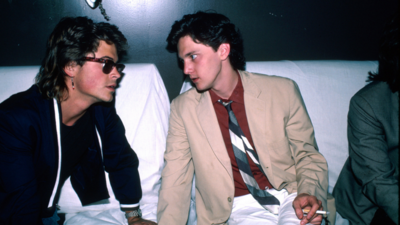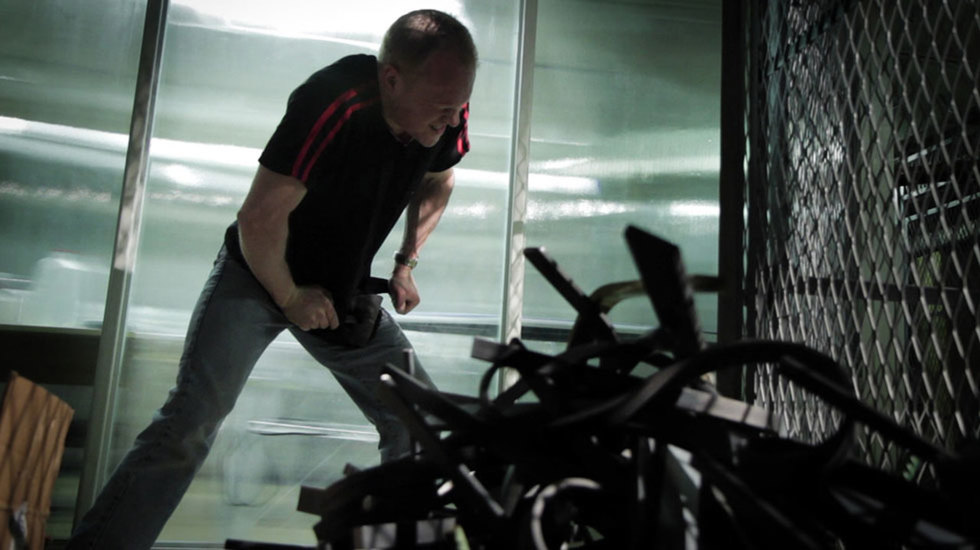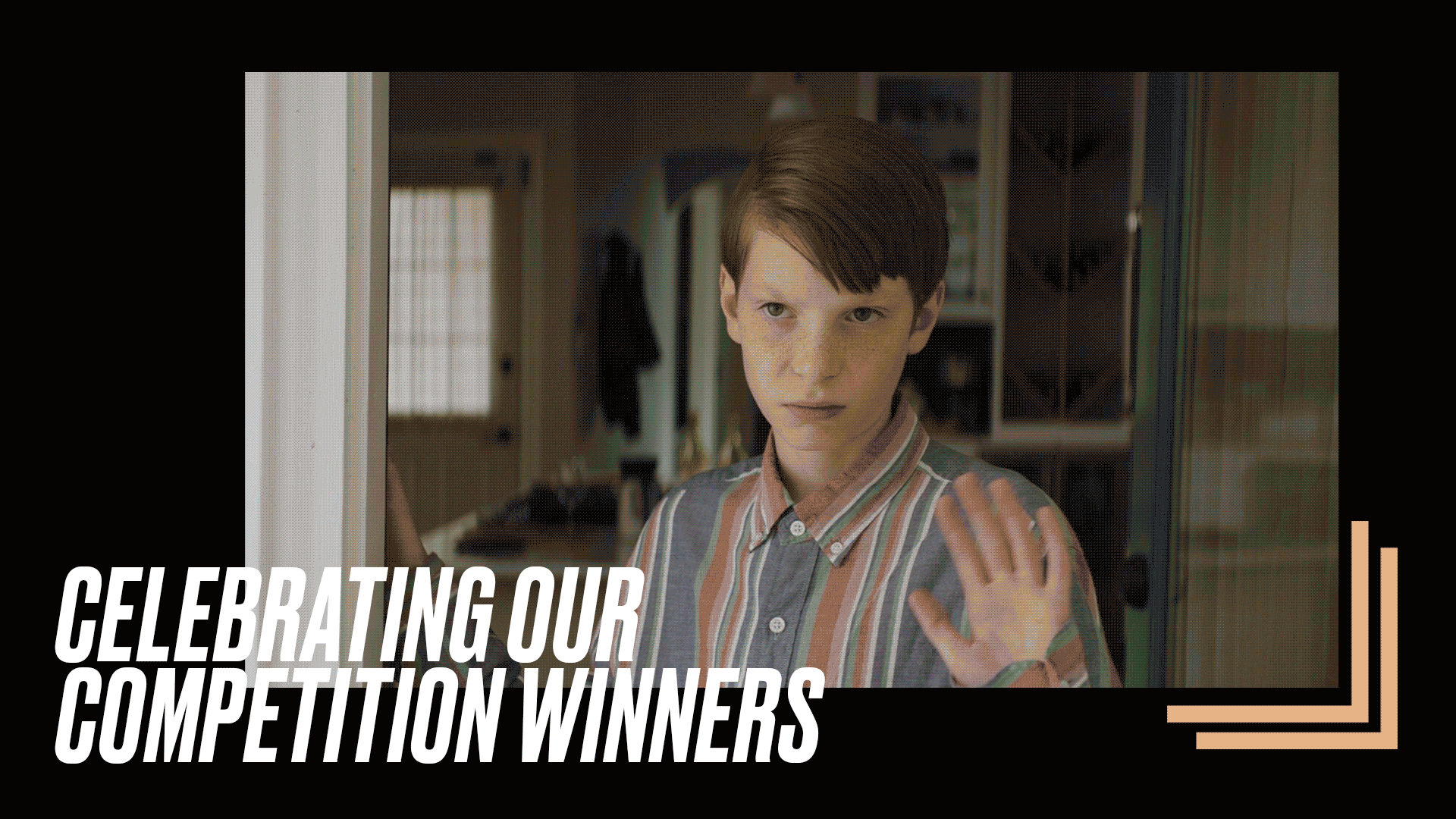
BY KAREN KEMMERLE |
‘Bending Steel’ Director Dave Carroll and Producer Ryan Scafuro on the Brotherhood of Strong Men
Dave Carroll and Ryan Scafuro, the team behind ‘Bending Steel,’ recall the first time they met Chris “Wonder” Schoeck and how they became experts on one of Coney Island’s most beloved traditions.

Tribeca: Tell us a little about Bending Steel. What inspired you to tell this story?
Dave Carroll: Bending Steel is about one man’s journey to overcome perceived limitations, both mental and physical. Inspiration for the film came from a random encounter with Chris Schoeck and the interaction that I initially had with him. Chris had a complexity of character that made him compelling. On one hand he was an introvert, not interested in interacting with people, but on the other, he was confident about his passion for bending steel and his interest in sharing it with me and an audience. This first conversation generated a multitude of questions and stoked my curiosity, so I followed his progress as he prepared to break out of his shell and enter the world at large.
Tribeca: How did you first meet Chris Schoeck, a man who aspires to be like one of Coney Island’s old time strongmen? What was your initial reaction to him?
DC: I was in the basement of my apartment building doing laundry with my dog, Gizmo. Out of nowhere, we heard a nondescript noise and then a clang of metal. Gizmo took off in that direction and I chased after her. We rounded a corner and standing before me, in from of an open storage space, was Chris Schoeck. Gizmo went inside to investigate, and I got a good look at what Chris was doing when I went in to pick her up. The storage space was crammed with an assortment of bizarre objects. Nails were bent and thrown in to piles, phonebooks where torn and heaped together, chains hung from the ceiling. To be honest it was very startling. I had a storage space in the basement as well, but it contained boxes of memorabilia, an old air conditioner and a bike. The contents of Chris’ storage space baffled me.
Two weeks later I ran in to him again. I had been thinking about his storage space ever since Gizmo and I stumbled upon it. I even told some friends about him. I couldn’t help but wonder. So I asked him what was going on down there. The result of that question was Bending Steel.

Tribeca: What was it like following Chris during his physical and mental training regimen? His drive and passion were inspiring, and I thought it was really interesting that you tended to focus more on his need to improve his showmanship rather than his overall strength. Were you conscious of that choice?
DC: Chris had a rigorous routine. He would not only be working every day bending steel in the basement but also training in a more traditional gym. After spending so much time with him, we had an incredible amount of footage that involved strength training. The problem was that Chris was comfortable training but he wasn’t comfortable with showmanship and getting out in front of people.
His deep-rooted fear of crowds and his reluctance to interact with people were the things that were going to prevent him from succeeding. That was the real conflict. He had a desire to become something that he wasn’t, and it was that transformation that we needed to focus on.
Tribeca: These strongmen form a brotherhood that seems difficult to penetrate. Were they accepting of you and your crew when you were following Chris around?
Ryan Scafuro: At first they were certainly a little wary. But Schoeck’s trainer, Chris Rider, is well respected in the community, and since we had his blessing, they tolerated us. It didn’t take long for them to recognize our interest as sincere. Even though they would joke around with us (both Dave and I are pretty small guys), I think they genuinely began to enjoy the outsider attention.
After being around them for a while, I finally tried to bend a nail myself, and eventually was able to do so. I think that surprised them, and they became very supportive of my bending, which grew our relationship. Once they saw that Dave and I had a very real appreciation for this thing they held very close to their hearts, we began to feel a true sense of acceptance and respect from them.
I suppose it is easier to put up walls and distance rather than seek out and receive approval.
Tribeca: One of my favorite parts of the documentary was the scene in which Chris and Chris went to visit Slim the Hammerman, who at the age of 76 was still lifting near impossibly weights. It was awe-inspiring. Can you talk about your reactions to the meeting Slim the Hammerman as it unfolded?
RS: Slim is a living legend. For Schoeck, meeting Slim was like meeting a hero, similar to a quarterback meeting Joe Namath or a boxer meeting Mohammad Ali. He was giddy, a little nervous, and once we got into Slim’s “dungeon,” he was like a kid in a candy store. There is no collection of strongmen memorabilia in the world like Slim’s. Chris was going around from wall to wall looking at the pictures and asking questions. And then when Slim took out his hammers, well the look you see on Chris’ face in the film says it all.
Tribeca: Chris “Wonder” Schoeck is a fascinating character. He seems very accustomed to purposeful isolation and limited social interactions. These tendencies make his urge to become a strongman and belong to this special group even more compelling to watch. How important do you think his parents’ approval is to him?
DC: From my point of view it would seem that Chris has struggled his whole life to secure approval whether from his peers, his parents and from people in general. His isolation could be a result of his not getting the desired response from people. If the response becomes reliably negative, the natural reaction could be the splintering of that relationship. I suppose it is easier to put up walls and distance rather than seek out and receive approval.
Over the course of filming Chris met a variety of incredible people. As these strongmen came into his life, they brought with them a wave of positivity and an authentic sense of acceptance. Instead of being the odd man out, Chris was finally accepted for who he was. It was obvious that these relationships began to replace what had been lacking in his life.

Tribeca: How much does Chris spend on steel and materials for his act in a month? Over the course of a year?
DC: According to Chris, he spends about $400/month on supplies, so nearly $5000/year. But I have a hunch that once this documentary is released, that number is going to increase a bit.
Tribeca: How did you work together to create the look of Bending Steel? What camera did you use during the shoot?
RS: We knew we would be shooting vérité style as we followed Chris, but we also wanted to include a little more production value and stylized elements than is normally found in the traditional vérité film. Fortunately, shooting on the Canon 7D allowed us to create a rich cinematic style, while still keeping our costs affordable. Because of the nature of Chris’ story, Bending Steel plays out much like a narrative film. We wanted to come as close as possible to creating an image quality that people would expect from a fictional movie, while still capturing those special moments that unfold while filming a documentary. I think the end product was successful in that regard.
Tribeca: Bending Steel was completed thanks in part to the aid of a successful Kickstarter campaign. Do you have advice for filmmakers who are trying to reach their funding goals using this site?
RS: Plan your campaign well. Take it as seriously as if you were raising funds traditionally, and do your research. We spent over a month looking at similar projects on Kickstarter before we even launched our campaign. We saw what worked and what didn’t work, which campaigns were successful and which weren’t.
Then after you launch, promote it hard. Reach out to press, to blogs, to anybody who may be interested in helping spread the word. It takes a much larger time commitment than most people realize. One of the most overlooked benefits of Kickstarter is that it builds awareness about your project early. We were able to create a fan base for Bending Steel well before the film was ever finished.
It was that transformation that we needed to focus on.
Tribeca: What are you most looking forward to at Tribeca?
DC: I’m most looking forward to meeting people at Tribeca. For me the most satisfying aspect of making this film was getting to know others. First I met Chris Schoeck, then his trainer Chris Rider, and then countless other people both in the film and on the side lines. Because of these new friendships, I have learned a lot. I find value in expanding my horizons in this manner. This may have been the unintended consequence of making a film about a guy who at one point was very isolated from others. Maybe it hit too close to home.
RS: Couldn’t have put it better myself.
Tribeca: What makes Bending Steel a Tribeca must-see?
DC: Bending Steel is a Tribeca must-see because it has a lot of heart and character. It will convince you that anything is possible as long as you believe that it can be done.
RS: The film explores a subject matter that not many people know much about, but it goes far beyond that. The transformation that happens within Chris and the personal journey that we witness on screen are so moving. Many social issue and political documentaries, while very important, often leave you with a feeling of sadness and frustration. Bending Steel is a heartwarming story that will leave you feeling hopeful and inspired.
Bending Steel premieres Saturday, April 20, at the AMC Loews Village 7. For more information and additional showtimes, please visit our Film Guide listing.

